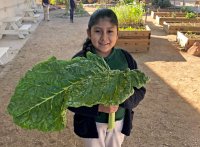Growing a School Community
An elementary school garden has fostered community by giving English-speaking staff and Spanish-speaking families a shared goal.
Your content has been saved!
Go to My Saved Content.My family left Colombia in part so that my sisters and I could live in a safer place. When we arrived in Chicago, the language and cultural differences between my family and the school staff concerned my parents—keeping our cultural identity would be challenging. My parents’ concerns continue to shape my thinking years later now that I’m a teacher at Crestwood Elementary School in Las Vegas, where over 80 percent of students are Latino. I wanted to help create a warm and welcoming school environment where all families, particularly first-generation Latino families, felt valued and respected. I wanted to help close the cultural and linguistic gap between families and the teaching staff.
I started by building an outdoor garden and mural program at my school. School gardens bring people together, helping to strengthen community relationships. The garden program has been successful, and as it has grown, it has become a home to our shared commitment to learn from each other. The garden also serves as a space for rich student-directed outdoor STEAM learning, provides increased access to healthy foods, and has helped improve student and school morale. And the garden is a natural place to teach our students about character and culturally responsive growth mindset. What better place for a student to learn that it’s OK to make mistakes than a garden where fixing mistakes easily becomes an observation lesson?
As teachers began to teach in the garden, we realized that it had another benefit: Teaching there is fun! We have added infrastructure to teach full lessons in the garden—tables and places to sit, so that students can work there. Students are far more engaged during lessons in the garden than we expected, and we teachers also feel happier.
Getting Families to Participate
Our build days brought over 200 people together to plant trees, paint murals, and construct tables, compost bins, and benches, with funding from the American Heart Association and Green Our Planet. I was intentional in designing the garden and murals to celebrate our community. That meant hiring Latino artists who painted brown children, and it included ethnobotanical planting—planting key ingredients of dishes that mirror the school population.
It also meant letting students take ownership of the garden. We created a garden club dubbed Gnomies by students (gnome + homie) to help maintain the garden, with the help of a local farmer. And in addition to being a place for teachers to hold classes, the garden is a place where school counselors can lead sessions and teachers and parents can build relationships—the students’ excitement to work on the garden encourages their families to come.
To fit parents’ and guardians’ schedules, we created free time for them to drop in without commitment. When we asked families what they would like and need, I learned that they enjoy being allowed on campus through the side gate where the garden is located, which acknowledges that they are active members of the community who we know by name and face. Because they don’t have to go to the front office and check in with their ID, they feel trusted.
Strengthening Teacher-Parent Bonds
The garden benefits the entire community by creating a space where community members and teachers are all perceived as equal in terms of their assets, knowledge, and contributions. The teachers and the school are not asserting power, and families’ strengths can shine. A few mothers, for example, are really knowledgeable about herbal remedies. They taught us how to use plant parts we would have composted, like artichoke leaves, which help lower cholesterol and improve digestive health.
The garden makes it easier for English-speaking teachers and Spanish-speaking families to connect. An English-speaking colleague told me that conversations with families happen naturally at the garden without the pressure that comes during parent-teacher conferences or behavioral citation meetings. She no longer feels self-conscious or “unprofessional” using the tiny bit of Spanish she knows, and started feeling comfortable talking with Spanish-speaking families.
“The garden was like an equalizer,” she said. “There were so many tangible elements that when having a conversation with families, you could point or help carry tools, or dig a hole together—that was our common language.”
To help foster communication between families and staff, I used both English and Spanish to welcome everyone at the start of our build days and to state our goals for the day. Bilingual signs around the garden support communication between teachers and families.
Our school garden has become a place where friendships blossom between families and staff. I think that without the garden, I would have missed out on meeting exceptional people in my community. Many mothers come every time there’s an opportunity to work in the garden. One mother, Melina, always wore a hat with a brim so big you could see her and her family from blocks away. Sadly, Melina lost her battle with leukemia and lymphoma just a week before school began this year. Although our school community is shaken by the loss of such a giving and vibrant soul, Melina will live on in the beauty she helped create in the garden.
The garden helps humanize us all. Many have realized by working in the garden that cultural and linguistic barriers do not impede us from building genuine relationships. Teachers used to complain about their perception of the lack of safety in the neighborhood. Since we built the garden, I’ve noticed that this perception has decreased significantly, and families feel more welcomed, too. I believe it’s because the garden is a space that is for families and by families—it’s a space that is separate from the systemic inequities that exist in the educational system.
